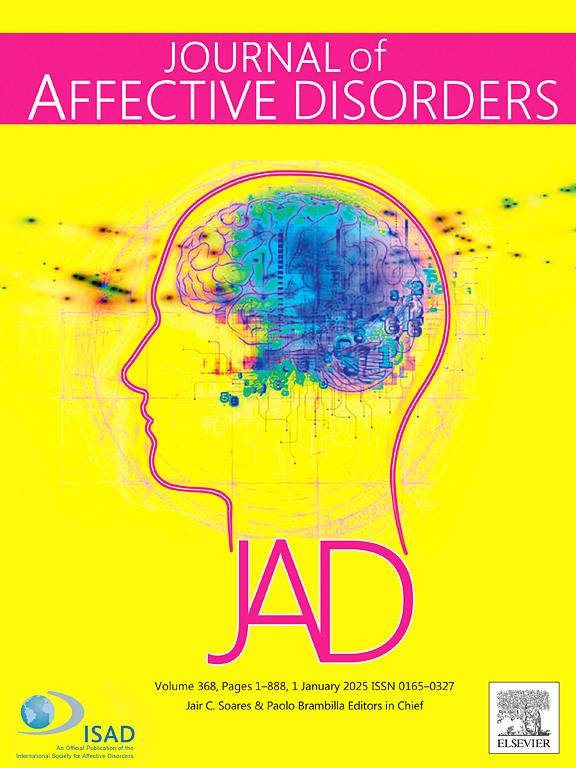Maternal perinatal cannabis use disorder and the risk of anxiety disorders in offspring: Insights from a longitudinal data-linkage cohort study
IF 4.9
2区 医学
Q1 CLINICAL NEUROLOGY
引用次数: 0
Abstract
Background
Cannabis use is increasing among pregnant women, but its effects on child mental health remain poorly understood. This study investigates whether maternal cannabis use disorder (CUD) during pregnancy and the postnatal period increases offspring risk of anxiety disorders.
Methods
We used linked administrative health data from New South Wales, Australia, covering 223,068 live births from January 2003 to December 2005. Maternal CUD and child anxiety disorders, including generalized anxiety disorder (GAD), phobic anxiety disorder (PAD), posttraumatic stress disorder (PTSD), separation and social anxiety disorders, were identified using ICD-10 codes. Generalized linear models (GLMs) with log-binomial regression estimated adjusted risk ratios (aRRs). Mediation and propensity score matching (PSM) analyses were also conducted to test the robustness of findings.
Results
After adjusting for covariates, offspring prenatally exposed to maternal CUD had a 79% increased risk of any anxiety disorder [adjusted risk ratio (aRR) = 1.79 (95 % CI 1.40, 2.26)]; specifically PTSD [aRR = 2.46 (95 % CI 1.78, 3.33)], GAD [aRR = 2.18 (95 % CI 1.03, 4.60)], and CADs [aRR = 1.91 (95 % CI 1.05, 4.60)], compared to non-exposed offspring. Postnatal CUD exposure was also associated with an increased risk of any anxiety disorder [aRR = 2.02 (95 % CI 1.22, 3.14)] and PTSD [aRR = 2.97 (95 % CI 1.56, 5.17)]. These associations remained significant in mediation and PSM analyses.
Conclusion
Maternal CUD during pregnancy and the postnatal period is associated with elevated risks of anxiety disorders in offspring. These findings highlight the need for targeted interventions, including perinatal counselling, to reduce anxiety risks in offspring.
母亲围产期大麻使用障碍和后代焦虑障碍的风险:来自纵向数据链接队列研究的见解。
背景:育龄妇女使用大麻的人数正在增加,但其对儿童焦虑症的影响仍未得到充分研究。本研究调查孕妇孕期和产后大麻使用障碍(CUD)是否与后代患焦虑症的高风险相关。方法:我们使用了澳大利亚新南威尔士州相关的行政卫生数据,涵盖了2003年至2005年的活产。使用ICD-10代码对孕产妇CUD和儿童焦虑症进行鉴定,包括广泛性焦虑症(GAD)、恐惧性焦虑症(PAD)、创伤后应激障碍(PTSD)、分离和社交焦虑症。采用对数二项回归的广义线性模型(GLMs)估计调整风险比(aRRs)。还进行了中介和倾向得分匹配(PSM)分析来检验结果的稳健性。结果:调整协变量后,产前暴露于母亲CUD的后代出现任何焦虑障碍的风险增加[调整风险比(aRR) = 1.79(95 % CI 1.40, 2.26)];特别是PTSD (aRR = 2.46 (CI 95 % 1.78,3.33)],广泛性焦虑症(aRR = 2.18 (CI 95 % 1.03,4.60)],和无赖(aRR = 1.91 (CI 95 % 1.05,4.60)],而无子女。产后CUD暴露也与任何焦虑症的风险增加有关[aRR = 2.02(95 % CI 1.22, 3.14)]和PTSD [aRR = 2.97(95 % CI 1.56, 5.17)]。这些关联在中介和PSM分析中仍然显著。结论:妊娠期和产后的母亲CUD与后代出现焦虑障碍的风险升高有关。这些发现强调需要有针对性的干预措施,包括围产期咨询,以减少后代的焦虑风险。
本文章由计算机程序翻译,如有差异,请以英文原文为准。
求助全文
约1分钟内获得全文
求助全文
来源期刊

Journal of affective disorders
医学-精神病学
CiteScore
10.90
自引率
6.10%
发文量
1319
审稿时长
9.3 weeks
期刊介绍:
The Journal of Affective Disorders publishes papers concerned with affective disorders in the widest sense: depression, mania, mood spectrum, emotions and personality, anxiety and stress. It is interdisciplinary and aims to bring together different approaches for a diverse readership. Top quality papers will be accepted dealing with any aspect of affective disorders, including neuroimaging, cognitive neurosciences, genetics, molecular biology, experimental and clinical neurosciences, pharmacology, neuroimmunoendocrinology, intervention and treatment trials.
 求助内容:
求助内容: 应助结果提醒方式:
应助结果提醒方式:


